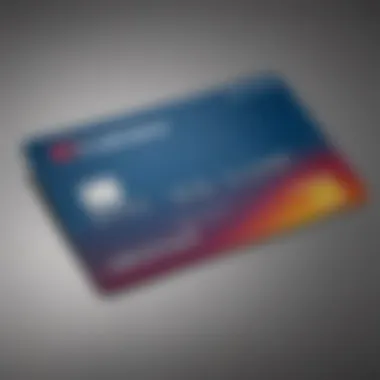Navigating Bad Credit Credit Cards with Capital One


Intro
Managing finance is a crucial skill, especially when one's credit score is not ideal. A credit score reflects how responsible an individual is with their borrowing and repayment behavior. For those who have a less-than-perfect credit history, navigating the landscape of credit products can be a challenge.
Capital One offers several credit cards designed particularly for individuals facing these difficulties. These bad credit credit cards aim to provide access to credit while facilitating a path towards better financial health. Understanding the features, benefits, and potential drawbacks of these options is essential for anyone considering applying.
This article examines Capital One's offerings, delving into the intricacies of their bad credit credit cards, the application process, costs involved, and overall impact on financial wellbeing.
Understanding Bad Credit
Understanding bad credit is crucial for anyone navigating the landscape of financial products, including credit cards from institutions like Capital One. Poor credit history can significantly limit options for borrowing, making it difficult to secure loans and access favorable credit terms. This section unpacks the concept of bad credit, its contributing factors, and the implications it bears on those seeking credit solutions.
Defining Bad Credit
Bad credit generally refers to a low credit score, typically below 580 on a scale that goes up to 850. This score is derived from various factors, including payment history, amounts owed, length of credit history, new credit, and types of credit used. A low score indicates that a borrower may have difficulty meeting their debt obligations in the past, raising red flags for lenders. Some may also experience difficulty obtaining loans or credit cards, especially from high-street banks.
Factors Leading to Bad Credit
Several key factors contribute to poor credit ratings, including but not limited to:
- Late Payments: Failing to make monthly payments on time can have significant negative effects on your credit score.
- High Credit Utilization: Using a large proportion of available credit can signal to lenders that you may be overextended financially.
- Bankruptcies: Filing for bankruptcy can drastically impact credit scores, making it challenging to secure loans post-filing.
- Collections: Accounts sent to collections strongly indicate risk to lenders and can remain on credit reports for years.
- Too Many Hard Inquiries: Applying for multiple credit products within a short time frame can be viewed negatively.
Understanding these factors is essential for individuals seeking to improve their credit scores, especially when considering credit options.
Impact of Bad Credit on Financial Options
Having a poor credit rating significantly constricts one's financial latitude. As a result, individuals may face:
- Higher Interest Rates: Lenders often offset their risk by charging higher interest for borrowers with low credit scores, leading to more expensive borrowing costs.
- Limited Credit Options: Access to certain credit cards or loans may be restricted. Institutions often have minimum score requirements, making it difficult for those with bad credit to qualify.
- Security Deposits: Some lenders, including those offering secured cards, might require upfront cash deposits as collateral if your credit is low.
- Insurance Premiums: Bad credit scores can sometimes influence insurance rates, pushing costs higher.
In essence, knowing the state of one's credit can empower an individual, assisting them in making informed financial choices.
Prelude to Capital One
Understanding Capital One's role in the credit market is essential for anyone looking to improve their financial situation, especially those with bad credit. Capital One offers products specifically tailored to individuals who face challenges securing traditional credit cards. This section delves into how the company operates and its philosophy regarding credit issuance. Knowing this not only helps consumers make informed choices but also clarifies the potential paths toward rebuilding credit with their offerings.
Overview of Capital One
Capital One is one of the largest banks in the United States, prominently recognized for its innovative financial products and services. Founded in 1994, the organization started as a credit card issuer but has since expanded its offerings to include banking and loans. Capital One is particularly known for providing access to credit cards for those with varying credit histories, including individuals with bad credit.
The bank’s strategic focus on tech-driven solutions allows it to streamline services and enhance customer experience. Capital One's digital tools enable customers to manage their accounts with ease, an aspect crucial for managing bad credit effectively. The company operates under a clear mission: to help people succeed financially. Through financial education and responsible credit options, Capital One seeks to empower consumers to take control of their financial futures.
Capital One’s Approach to Credit Cards
Capital One adopts a progressive approach to credit card offerings, especially concerning those with bad credit ratings. The firm focuses on providing accessible options that help consumers not only manage their credit but also improve their credit scores over time. Unlike some card issuers that might impose restrictive requirements, Capital One seeks to offer more opportunities for approval, which is critical for individuals seeking to rebuild their credit.
When designing its credit cards, Capital One emphasizes responsible borrowing and transparent terms. Each card comes with clear guidelines that outline fees, interest rates, and rewards structure. This transparency can alleviate the confusion that often surrounds credit cards, making it easier for consumers to understand the financial obligations associated with their credit use.
Bad Credit Credit Cards Offered by Capital One


Bad credit credit cards are crucial for individuals looking to rebuild their credit. Capital One offers several options tailored for those with less-than-ideal credit scores. These cards can help users manage their finances effectively while progressively improving their credit ratings. The offerings from Capital One stand out due to their unique features and rewards that can motivate responsible credit usage.
Types of Bad Credit Credit Cards
Capital One provides a range of credit card options suited for those with bad credit. These include secured and unsecured cards. Each type has distinct characteristics, which cater to various needs.
- Secured Credit Cards: These cards require a security deposit. The deposit acts as collateral and usually equals the credit limit. For example, if a user deposits $200, the credit limit is typically $200. This setup minimizes the risk for the lender, thereby making it easier for individuals to obtain a card.
- Unsecured Credit Cards: Unlike secured cards, unsecured options do not require a deposit. However, these cards often come with higher interest rates and fees to offset the risk of lending to higher-risk individuals.
Both types can help users establish or rebuild credit history if managed carefully. Regular, on-time payments are essential in raising credit scores, regardless of the card type.
Secured vs. Unsecured Options
When choosing between secured and unsecured credit cards, one must consider their financial situation and goals.
Secured Options: Secured credit cards are often more accessible for individuals with poor credit history. They provide a great way to practice good credit habits. By making small purchases and paying them off in full each month, users can show lenders they are responsible.
Benefits of secured cards include:
- Lower acceptance barriers for those with bad credit.
- Opportunities to graduate to unsecured cards after a period of responsible use.
- Protection against overspending, as the credit limit matches the deposit amount.
Unsecured Options: Unsecured credit cards provide more flexibility in usage, without requiring upfront cash. However, the absence of a security deposit often translates to fewer available credit lines and higher costs.
Benefits of unsecured cards include:
- Immediate access to credit without the need for a deposit.
- Rewards programs that can offer some cash back or points, though these rewards may not be as robust as those offered to higher-tier customers.
Both options can aid in contrast, depending on personal financial goals and capability to manage credit wisely.
Benefits of Capital One Bad Credit Credit Cards
Understanding the advantages of bad credit credit cards from Capital One is vital for individuals looking to rebuild their financial standing. These credit cards are often tailored specifically for those with a less-than-ideal credit history, and they come with significant benefits that can aid in improving credit scores over time. By choosing Capital One, users can access resources and support tailored to help navigate the complexities of bad credit management.
Building Credit Responsibly
Capital One's bad credit credit cards offer a structured path for building credit. With responsible use, cardholders can see a gradual improvement in their credit scores. Payment history is a critical component of credit scores, and making regular, on-time payments is essential. It is advisable to keep utilization low, ideally under 30% of the available credit limit. This practice showcases financial responsibility and can lead to a more favorable credit rating over time.
Moreover, Capital One reports to major credit bureaus, which is beneficial for users aiming to recover from a bad credit situation. Maintaining a positive payment history can not only improve scores but can also open doors to other financial opportunities in the future, such as unsecured credit cards or favorable loan terms.
Reward and Cashback Programs
In addition to the credit-building aspect, Capital One provides certain bad credit credit cards with rewards and cashback features. While many bad credit cards lack these incentives, Capital One stands out by offering some level of rewards for everyday spending. For instance, cardholders can earn cashback on purchases made in popular categories. This not only offsets some expenses but encourages responsible spending habits that align with good financial practices.
Furthermore, these rewards may serve as an added motivation for cardholders to maintain a disciplined financial approach. Users should review the specific cashback or rewards structure applicable to their chosen card, as they can vary. In a landscape where many similar financial products offer minimal benefits, Capital One’s commitment to incorporating rewards for users with bad credit is noteworthy.
"The right strategy with your credit card can lead to a better financial future."
To summarize, the benefits of Capital One's bad credit credit cards extend beyond mere access to credit. They provide a comprehensive opportunity for responsible financial management, along with potential rewards that can enrich the user experience.
Potential Drawbacks
When exploring the options for bad credit credit cards, understanding the potential drawbacks is essential. Capital One offers credit cards that cater to individuals with challenging credit histories. However, these advantages often come with certain risks and limitations. Recognizing these drawbacks can equip consumers to make informed decisions and avoid pitfalls that can worsen their financial situations.


High Fees and Interest Rates
One significant drawback of bad credit credit cards from Capital One is the potential for high fees and interest rates. Consumers with poor credit scores often face elevated financial charges compared to individuals with better credit ratings. These fees can include annual fees, late payment fees, and foreign transaction fees.
Interest rates on these cards are generally higher, sometimes even exceeding 25%.
Here are a few points to consider regarding fees and interest rates:
- Costs Add Up: Paying late can lead to additional charges. Consistently missing payments can lead to a cycle of growing debt.
- Cash Advance Fees: Using a card for cash advances can incur extra fees and higher interest rates.
- Impact on Credit: High utilization of credit, alongside burdensome fees, can negatively impact credit scores further.
While bad credit credit cards can offer a second chance, it is crucial to understand if the fees outweigh the benefits.
"The cost of using a credit card is as important as its rewards; always read the terms and conditions carefully."
Credit Limit Restrictions
Credit limit restrictions are another aspect that consumers need to navigate carefully. Bad credit credit cards typically come with lower credit limits. This can be frustrating, especially when unexpected expenses arise. Lower limits can also affect credit utilization ratios, which play a crucial role in determining credit scores.
Considerations include:
- Building Credit: With low limits, it may be difficult to build credit effectively. It’s essential to maintain a low credit utilization ratio, which often requires careful budgeting.
- Flexibility Issues: A limited credit line can lead to challenges in managing larger purchases or emergencies, forcing consumers to rely on other financial avenues.
- Potential for Denial: Further financial needs may be difficult to manage with a low limit, possibly resulting in denials for additional credit lines.
Understanding these limitations is vital in making beneficial financial decisions. Being aware of these potential drawbacks helps consumers set realistic expectations and strategize effectively when managing a Capital One bad credit credit card.
Application Process
The application process for bad credit credit cards is a crucial element in understanding how to improve one's financial situation. For individuals with a low credit score, the process may appear intimidating, but knowing what to expect can simplify it significantly. Understanding the steps involved can empower readers to tackle their credit challenges more effectively. It can also clarify the requirements that institutions like Capital One set for applicants. This understanding may pave the way for better financial opportunities in the future, helping individuals regain control over their credit.
Eligibility Requirements
Eligibility requirements for Capital One bad credit credit cards are essential for potential applicants to grasp. These criteria can vary based on the specific credit card chosen, but some general guidelines typically apply:
- Minimum Age: Most applications require the applicant to be at least 18 years old.
- Social Security Number or Tax ID: This is often necessary to verify identity.
- Residency: Applicants usually need to be legal residents of the U.S.
- Income Verification: Proof of income may be requested to assess the applicant's ability to repay debts.
- Credit History: While the focus is on individuals with bad credit, even a minimal credit history is often factored into the decision.
These elements serve as the basic foundation for determining one's eligibility. Not meeting one or more requirements could result in application denial, making it crucial to methodically assess personal circumstances before applying.
Step-by-Step Application Guide
Navigating the application process can be straightforward if one follows a structured approach. Below is a step-by-step guide for applying for a bad credit credit card through Capital One:
- Research Available Options: Start by reviewing the different bad credit card options Capital One offers. Each product may have unique features, fees, and rewards, so filtering through them can help choose the best fit.
- Check Eligibility: Before proceeding with an application, verify if you meet the eligibility requirements outlined above. This step can save time and prevent unnecessary credit inquiries.
- Gather Required Documents: Prepare necessary documentation, including proof of income and identification. Ensuring these are ready can streamline the online application.
- Fill Out the Application Form: Visit Capital One's official website and locate the application section for bad credit credit cards. Fill in all required fields accurately, including personal and financial information.
- Review the Application: Before submission, double-check for any mistakes or omissions. An accurate application is vital for approval.
- Submit the Application: After reviewing, submit the application. Most applications are processed quickly, often stating approval or denial within minutes.
- Monitor for Updates: Keep an eye on your email for any updates or requests for additional information from Capital One as they review your application.
By following these steps, potential applicants can approach the application process with a clear plan. Understanding each stage and what is required can lead to a more favorable outcome.
Managing Your Bad Credit Credit Card
Managing a bad credit credit card is an essential aspect for individuals looking to improve their financial standing. It goes beyond merely holding a credit card. Proper management enables the cardholder to rebuild their credit score, access better financial products in the future, and develop responsible spending habits. A common myth is that bad credit cards only serve as a temporary solution. In reality, they offer a pathway to financial recovery when managed well.
Making Payments and Avoiding Debt
Timely payments are crucial when it comes to bad credit credit cards. Missing payments can lead to additional fees and a further decline in credit scores. Here are some strategies to ensure timely payments:


- Set up automatic payments: Many banks, including Capital One, offer this service. This approach ensures that you never miss a payment.
- Create reminders: If automatic payments are not your preference, use calendars or apps to remind you of upcoming due dates.
- Pay more than the minimum: While the minimum payment keeps you in good standing, paying more reduces your overall debt faster and decreases interest accrued.
Avoiding debt is a fundamental part of managing your credit card. Here are practical tips:
- Stick to a budget: Knowing how much you can afford to spend can prevent overspending.
- Review your statements: Regularly checking your transactions helps to identify any unauthorized charges quickly.
- Seek help if needed: If debt becomes overwhelming, consult with a financial advisor or a credit counseling service. They can provide tailored strategies.
"Effective money management starts with understanding your spending habits."
Monitoring Your Credit Progress
Monitoring your credit progress is as essential as managing your credit card payments. Keeping track of your credit score can guide you in making informed financial decisions. Here are several aspects to consider:
- Obtain free credit reports: AnnualCreditReport.com offers free access to your credit report from major bureaus. Review it for errors that could affect your score.
- Use credit tracking tools: Several online platforms and apps help monitor your score in real-time, alerting you to any significant changes.
- Set goals: Based on your credit report and score, establish clear goals for where you want to be in six months or a year. This sets a timeline and motivates you to stay on track.
Regularly assessing your credit health allows you to celebrate small victories while identifying areas that need adjustment. With diligence, managing a bad credit credit card can lead to improved financial opportunities over time.
Alternatives to Capital One Bad Credit Credit Cards
Exploring alternatives to Capital One's bad credit credit cards is essential for individuals looking to rebuild their credit history. While Capital One offers notable options, other products may fit specific needs better. Evaluating different credit cards and financial institutions helps users make informed choices. This section discusses various alternatives and their potential benefits.
Other Credit Card Options for Bad Credit
Many financial institutions have tailored credit card offerings for people with poor credit. Options include:
- Discover it® Secured Credit Card: This card not only helps build credit but also offers cashback on purchases. Users deposit an amount that acts as their credit limit.
- OpenSky® Secured Visa® Credit Card: This card does not require a credit check, making it accessible. It focuses on responsible usage to help improve credit scores.
- Secured Mastercard® from Capital One: Similar to other secured cards, it requires a deposit but can lead to unsecured options with consistent payments.
- Credit One Bank® Visa® Credit Card: Designed for individuals looking to improve their credit. It boasts rewards programs for spending, but it’s vital to review fees carefully.
Considering these options provides flexibility. Individuals should examine annual fees, interest rates, and credit reporting by each card issuer. Certain cards may offer low fees or reward systems that enhance the user experience.
Credit Unions and Their Offerings
Credit unions provide another viable pathway for those with bad credit. Credit unions often emphasize community and member support, which can result in favorable terms for individuals with low credit scores. Key attributes include:
- Lower Fees: Credit unions typically have reduced fees and interest rates compared to traditional banks.
- Personalized Service: Being member-focused, credit unions often provide better customer service and allow for discussions about individual financial situations.
- Member Education: Many credit unions offer resources and financial advice to help members manage their finances.
- Rebuilding Programs: Some credit unions create specific programs aimed at helping members improve their credit scores systematically.
For example, Navy Federal Credit Union offers credit cards aimed at those starting their credit journey. Their products may feature lower rates and no annual fees, making them more appealing than traditional credit cards.
Credit Unions present unique offerings, which are often more beneficial than conventional banks. By understanding and exploring their options, individuals can choose a path that aligns with their financial needs and goals.
Closure
The conclusion of this article emphasizes the significance of understanding Capital One's offerings for individuals with bad credit. In today’s financial landscape, poor credit can limit access to essential credit products. However, Capital One provides various credit card options that cater specifically to those with less-than-perfect credit histories. These cards can serve as a bridge to rebuilding credit while granting some financial flexibility.
Final Thoughts on Capital One Credit Cards
Capital One’s credit cards designed for bad credit holders offer a unique pathway towards financial recovery. They provide a way to not only manage everyday expenses but also to build or improve one's credit score over time. It is essential to weigh the features and terms carefully.
With cards like the Capital One Secured Mastercard, users can make small deposits that serve as collateral. This structure helps mitigate the risks for the issuer while allowing the cardholder to benefit from credit utilization and timely payments. Additionally, many users appreciate no annual fees as a crucial aspect when selecting a card.
"A poor credit score does not have to be a barrier to financial tools that can assist in recovery."
Empowering Financial Decision Making
Empowerment in financial decisions originates from knowledge and a clear understanding of one’s options. Learning about bad credit credit cards can pave the way for smart choices. It is vital to not only select a card that fits individual needs but also to align it with broader financial goals.
When applying for a Capital One credit card, consider the implications of interest rates, fees, and potential credit limits. Make regular payments and monitor financial progress to see improvements in your credit score. This proactive approach not only illustrates responsibility to lenders but also fosters a sense of financial security.
Ultimately, being informed and educated about the options available from Capital One can lead to better financial management. Whether for young professionals, families, or students, these insights encourage a more strategic and effective approach to handling personal finances.



